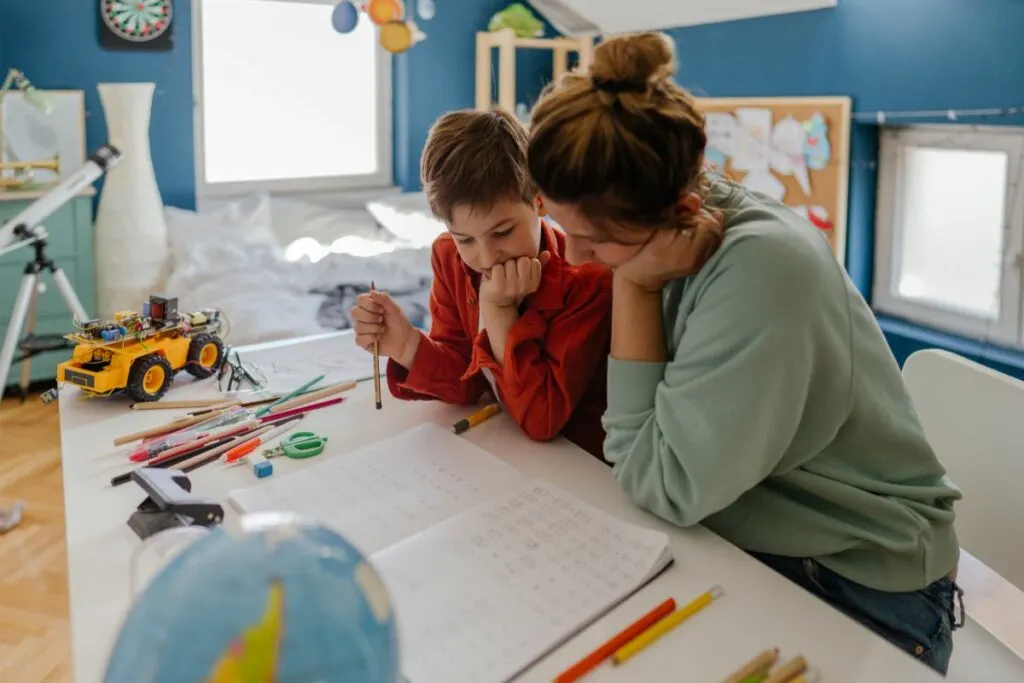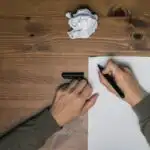Whether you decide on using a dining room table or painting your own chalkboard, your homeschool room ideas need not be expensive.
Creating a productive learning environment can be done on a budget so you can concentrate on delivering a focused education.

You may still have to fork out for the latest workbooks for the year’s curriculum. Yet, with some handy tips and hand-me-downs, you can create an ideal homeschool room without spending too much money.
1. Paint Your Own Chalkboard
Try not to be over-elaborate with your homeschool room, as you may only need a small yet dedicated learning space to deliver lessons.
A wall space is ideal, and you only need room for a chalkboard if you truly need one to write out what you want to teach.
Paint your chalkboard onto a single wall, and you could alternate between using it and using the same space for a foamboard, a whiteboard, or to hang up a map when you need to for the odd geography lesson.
Of course, you will require seating in front of the chalkboard, and, depending on your homeschooled child, you may only need a small stool or a more formal chair.
Give yourself enough space for your own seat, and make sure it is not too cramped for when you need to stand up to write something on the chalkboard or pick out educational materials.
If you need some extra space, then you can consider moving some household items instead. It may be time to get rid of that old chair no one sits on or the bookcase that contains books that are no longer read.
2. Use The Dining Room Table For Lessons And A Smaller Table For Crafts
There are some essential requirements for a learning space. Make sure that the seat can sit alongside a desk and that your child can comfortably write on it.
That may mean stripping the dining room table of any materials you use for family meals and keeping it stark during the day.
That way, you can still use your dining room table, yet it looks more purposeful for lessons.
Should you have enough room, source a smaller table, perhaps sand it down, and use it for more creative pursuits like crafts.
Learn to declutter effectively so you can work out where your learning environment can go and how far it can extend.
If you are planning to homeschool for the first time, this could be the ideal time to throw out items you no longer use.
Perhaps some kitchen items so you can use the kitchen table as a class desk or just have a yard sale or, alternatively, move some stuff into the basement or take it to a Goodwill store.
3. Invest In Convertible Seating And Desks But Use The Couch On Occasion
Consider how truly economical you can be about the space that you use with the seating and desks.
You will still need desks, yet convertible ones are available, which can seriously create some much-needed room at the conclusion of another school day.
Try to source some old folding chairs that you can spruce up with a lick of paint.
For that extra touch, find a cushion to make the seating more comfortable, and then fold them away once you are done.
If you do not mind spending the time and energy to move some of your furniture around, then you can re-purpose your living space.
Keep the couch and TV in place in case you want to watch some educational videos. That same space can be used for reading and hanging out, yet you can move to a desk that has more purposeful seating in another room.
4. Try To Only Use Recycled Or Pre-Used Learning Materials
As your homeschooled child gets older, you may find yourself having to buy new equipment and books. This is where you can get creative on a budget and perhaps include some Goodwill finds.
Should last year’s textbooks still be in date, then you can sell them on eBay to help fund the upcoming year’s material.
Perhaps another parent in your homeschooling network has some material that they no longer need, and they can hand them down.
Once your child moves onto other, more advanced aspects of a curriculum, it should be time to invest in the essential equipment.
That could mean new workbooks, new science equipment, and possibly even new seating once they have grown.
Again, try to find hand-me-downs and keep your spending to the essentials of the new required textbooks.
5. Do Your Own Decorating
If you enjoy getting creative and doing your own decorating, then take the hands-on approach to creating your homeschooling environment.
This is another aspect that can change over time, so be prepared to mix it in. When they are younger, you can decorate the space with numbers, letters, and spaces to get them started on basic academic skills.
Over time, this can advance to historical documents, maps, and engineering diagrams.
Perhaps at an early age, you can paint an entire wall to create a giant chalkboard. Even take the time to write out the day’s lesson plan alongside some motivational quotes.
Get creative and involve some history with some events that happened on that day in years gone by.

6. Create Your Own Storage Containers As A Crafts Lesson
Instead of heading out to buy specialist plastic containers for your child’s pens and crayons, involve them in creating your own storage tools. That could mean a quick crafts lesson in painting some plastic cups and reusable food containers.
Of course, all the material will need a quick wash first, yet before throwing anything out, think about how you can recycle it for homeschooling.
With a larger plastic container or box, you can create your child’s portable homework station. Simply ensure it has enough room for workbooks and stationery, then decorate it however you see fit.
Once the school day is over, you can move the homework station to their bedroom and let them get going.
Those reusable plastic containers can be re-purposed to contain all sorts of vital homeschool equipment.
That could be activity books and coloring books, crayons, markers, and stamps. Your own dedicated storage facility in a cupboard can also help you keep on top of all those supplies.
7. A Makeshift Reading Nook
With a young homeschooled child who is keen on reading, you can create their own makeshift reading nook. Choose a corner of the room, re-purpose some large floor pillows, and fill a basket with their favorite books.
When you think your child could do with a break, let them loose in the reading nook and allow them some time to get stuck in a book.
8. Wall Decoration With Their Artwork
What better way to decorate some empty wall space than by showing off your homeschooled child’s artwork? Many parents struggle to find room on their fridge for their latest child’s masterpiece.
If you want to make your child feel proud of their work, then stick it on the wall to create an art gallery you can both be really proud of.
As your child gets older, you can swap out some of their earlier works for more recent efforts.
9. Mix Up The Wall Space And Keep The Homeschool Room Invigorating
However you decide to design your homeschool room, keep it invigorating. Mix up the wall space depending on the lesson plan.
For instance, if you have a history lesson, then find a quote to write down on the chalkboard or a picture of someone relevant to the lesson.
For an art class, find examples of famous works of art that you can put up as pictures or show on a tablet.
To help your homeschooled child learn, introduce some more practical lessons to maintain their interest.
Head outside to learn from nature or take a trip to a local museum to learn some history. Involve your child in cookery to learn some home economics while creating a delicious meal that the rest of the family can enjoy.
You may even want to involve some limited screen time by finding a relevant video to show them on a tablet or on the TV.
10. Change It Up For The Seasons
As the seasons change, you should be prepared to change up the homeschool room accordingly. Introduce some flowers during spring, some sand-based playtime activities for summer, a decorated pumpkin for fall, and festive decorations for winter.
Simply pick up some flowers on a nature walk and try to keep using the same sand for a variety of activities.
Chances are, you will be getting a pumpkin and festive decorations when the time comes anyway.
Final Thoughts
Creating a homeschool room for your child can be a joy, and it can be done on a budget.
You will need to get creative, and you may want to dust off your decorating skills.
From using a vacant wall for a painted chalkboard to decorating the space with their artwork and creating your own storage space, you can get creative as you create the perfect homeschooling space.
- Homeschooling In High School: Pros And Cons - February 24, 2024
- How Do I Withdraw My Child From School To Homeschool? - February 23, 2024
- How To Not Go Crazy Homeschooling Kids: A Guide For Frazzled Parents - February 22, 2024









Leave a comment